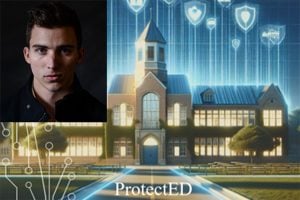
In his job as a cyber engineer at Oasis Systems LLC in California, Dakota Robbins not only helps identify weaknesses in networks and computer systems but also creates and tests security measures to help organizations improve their defenses against real-world threats.
Drawing on his background in cybersecurity and bachelor’s degree in information systems technology, he developed ProtectEd as his capstone project for his master’s degree in Johns Hopkins Engineering for Professionals Systems Engineering program.
ProtectED, a comprehensive cybersecurity and safety system designed for educational institutions, safeguards against a wide range of threats, including active shooters, natural disasters, and other emergencies. ProtectED leverages a school’s existing security system, integrating smart devices and technologies to bolster campus safety and security.
“Most educational institutions lack a cybersecurity framework capable of offering physical protection for students, faculty, and infrastructure,” Robbins said. “ProtectED’s goal is to shield educational communities from diverse dangers, integrating into existing network infrastructures and notifying emergency services promptly and in detail.”
Based on systems engineering principles, ProtectED’s automated system is designed to interpret various data inputs—from sound decibel levels to weather conditions—and deliver vital information to stakeholders during critical situations.
“Decibel readers would be placed in classrooms and hallways to determine if a gun has been fired in a specified area via a decibel monitor. For example, if the volume of a classroom reaches a specified decibel level, then an alert would be sent to authorities and the IT team that a firearm has been potentially discharged. Weather stations that communicate that inclement weather is approaching the surrounding area alert ProtectED. These reports are then synchronized with the operation of other subsystems, like smart windows,” he said.
One of Robbins’ biggest challenges was figuring out exactly what the ProtectED system needed to do and how to incorporate those requirements into the system. After interviewing area directors and cybersecurity professionals about their needs and concerns, he translated them into requirements for ProtectED.
“As the system matured, I better understood what was necessary and how to integrate requirements that would capture these needs,” he said. “As I developed the conceptual design report, test plans, and system specification a-specs, the system began to build itself. Understanding this, I more easily grasped what needed to be removed or expanded on over the system’s lifecycle.”
He used systems modeling tools like Cameo to create detailed diagrams that explained the physical and data flow connections between subsystems, ensuring ProtectED’s robustness and reliability. The resulting system integrates into a school’s existing security system, leveraging various smart devices and technologies to enhance the overall safety and security of the campus.
Robbins says his EP coursework was “directly applicable to” his capstone project and that the program’s emphasis on real-world applications and problem-solving allowed him to seamlessly transfer knowledge from his classes to his final project.
“By completing this project, I am now considering pursuing full-scale development of ProtectED,” he said.
For Robbins, pursuing a master’s degree in systems engineering was a strategic decision.
“Given my schooling and career, it made sense to develop the ‘other half’ of my career field academically,” he explains.
He offers other students tackling a master’s degree this advice: “Understand the material and what the professors are asking for. The assignments may be vague intentionally, allowing you to figure out what is necessary to satisfy these needs through your research.”